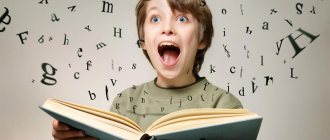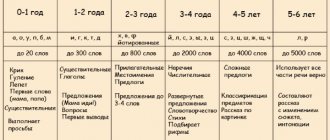Speech disorders are one of the most pressing children's problems. According to statistics, the number of children with speech pathologies is growing. Therefore, it is important to diagnose possible difficulties in a child’s speech development in a timely manner. You can and should come for a consultation with a speech therapist before the age of three: the earlier correctional work is started, the more effective the result will be.
What is meant by “speech impairment”? These are difficulties in communicating with others. They can manifest themselves in distorted sound pronunciation, unclear diction, difficulties in composing sentences and phrases, and sometimes the child practically does not speak. Correct diagnosis will help determine ways of correction in order to integrate the child into a normal speech environment as much as possible.
Signs of speech delay
You can notice deviations in speech from the first months of a child’s life. Particular attention should be paid to children born to mothers with an unfavorable obstetric history or difficult labor. Premature and low birth weight babies are also at risk.
In the first months, pay attention to the sound of the cry. For a baby during this period, screaming is a means of interaction with the outside world. In children with normal speech development, it is clear and sonorous. And in a baby with a speech delay, the cry is quiet or too loud, similar to sobs or screams. Some may not have it.
Important milestones in a baby's verbal development are humming and babbling. In children with speech disorders, humming and babbling have no intonation coloring. And if the baby is deaf, then the babbling stage (repetition of identical syllables) is absent. It is worth paying attention to the development of speech if the baby does not respond to an adult’s address and is at the stage of babbling or “babbling words” for too long.
For such babies, babbling does not act as a means of communication with other people. They may also experience negative reactions to new environments or people, and they may become selective in communication and playing with objects. This may cause a delay in verbal development. A child with speech development disorders does not understand speech addressed to him and does not imitate adults. If you notice these signs in your baby, you should contact a speech therapist.
To prevent difficulties in speech development, it is important to communicate more with the baby and encourage his desire to interact with the outside world. If there are signs of deviation from the norm, you should consult a speech therapist. As the child gets older, the signs of speech development disorders become more pronounced. Therefore, encourage your child to strive for communication and knowledge of the world around him.
Stages of speech development by age
The development of speech is reflected in the table - it occurs in several stages:
| Dorecheva - from birth to 12 months | - by 2 months the baby begins to walk and babble - by 7 months. pseudowords appear - by 8 months - the first babbling words, by a year up to 30 such words Closer to one year, the baby gradually learns intonation, melody, and rhythm of conversation. Fulfills requests |
| Pre-grammatical - stage of primary speech development (from one to 2 years) | — the dictionary is replenished with new words - by 2 years old knows 250 - 300 words - everyday speech appears |
| Grammar acquisition stage (third year of life) | - they speak, but cannot yet formulate phrases grammatically - express their thoughts and desires - sentences from one word, and later from 3-4 words - function words appear - understand the stories of adults about phenomena and events in which they did not personally participate - speech gradually becomes more coherent |
| From 3 to 4 years | — children’s vocabulary is actively expanding (up to 2 thousand words) - a sense of language is formed - extended speech - can make rhymes, learn poetry |
| From 4 to 5 years | - with normal speech development, five-year-olds already speak coherently and competently - know up to 4000 words - can make up a story based on a picture - know the classification of objects |
| From 5 to 6 years | - know up to 5000 words - use all parts of speech - can compose a complex story based on a picture, change the plot |
Levels of speech development in children by age
At each period, the baby must master certain skills.
From birth to 12 months
In the period from birth to the end of infancy, speech development by age (month) occurs in this way.
Immediately after birth, the newborn makes its first sound - a cry. During the first month of his life, he learns to respond to someone addressing him - depending on the intonation, he cries or smiles.
From about 2 months. the baby begins to roar. At the same time, he listens to his own sounds. Moreover, all over the world children walk the same way!
From 3 months, babies begin to babble. This is the beginning of mastering the phonetics of the native language.
At 5 months, babies take a closer look at the articulation of adults and try to copy it. A six-month-old baby can say individual syllables for the first time (for example, “ma-ma”) and begins to associate objects with sounds (“meow” - “cat”). That's when you need to start talking to him a lot.
At 7 – 8 months. Babies constantly babble, and understand the meaning of individual words. Semantic pauses appear: the baby “says” something and falls silent - waiting for the adult’s answer. These are his first attempts to communicate with people - answer your child!
At 9–10 months, with normal speech development, the first words may appear. Now “mom” is not just a syllable, but a meaningful word. The babbling becomes more complex. Children listen to what adults say. The passive vocabulary is expanding. It is necessary to create favorable conditions for the baby to develop a vocabulary.
By 12 months, the baby speaks from 2 to 10 words, can pronounce “a”, “u”, “i”, “m”, “b”, “p”.
Stage of development of active speech - from 1 to 2 years
The baby likes to repeat words and syllables after his parents. He's doing it wrong so far: he uses one word to mean several things at once. For example, “bibi” is any type of transport and movement. He actively uses gestures and facial expressions.
By the age of 1.5 years, the passive vocabulary is supplemented by 100 words, they begin to speak in simple sentences of two words (for example, “Uncle Bibi” (this can mean a man in a car and the action - a man drives a car). These are signs of the emergence of phrases.
Two-year-olds can pronounce more sounds: “f”, “x”, “v”, “d”, “k”, “o”, “n”, “t”, and three-year-olds - “l”, “s”, “ Hey".
Preschool period - from 3 to 6 years
Includes junior (3 – 4 years), middle (4 – 5), senior (6 – 7) preschool age. Let's consider age-related norms for speech development in preschoolers.
Three-year-old children have about 3,000 words in their vocabulary, and it is constantly growing. Almost all younger preschoolers pronounce sounds incorrectly, which may be a reason to contact a speech therapist. Their conversation is interesting: they make up new words.
At 3–4 years of age, speech development, according to the table, is characterized by excellent pronunciation of “ts”, “y”, “z”, at 5 years - “zh”, “sch”, “r”, “ch”, “sh”. But many replace hissing ones with whistling ones (“puppy” - “senochka”).
Four-year-old children are “why kids”. They constantly ask questions, the task of adults is to answer them. It is then that the sense of language is formed. Kids can replace or omit syllables, use endings, prefixes, suffixes incorrectly, do not agree words in sentences, place stress incorrectly - this is all normal, because their grammatical structure is just being formed. But phrases are being improved: adjectives appear.
With normal speech development, a five-year-old preschooler can retell a fairy tale or come up with a story based on a picture. The story becomes more varied and correct. Hissing sounds are good, and some guys are good at “r”, but more often it’s isolated. They feel intonation and can change the strength and pitch of their voice down to a whisper. The dictionary is rapidly expanding with new words that are easy to remember.
As can be seen from the table of speech development, older preschoolers are at an even higher level. Six- to seven-year-old children clearly pronounce sounds and can identify them in words. This is important when preparing for school. But the vocabulary of all six-year-olds is different: for some it is very rich, while for others it is limited to everyday topics. The grammatical structure of speech is formed, although verbs may be conjugated incorrectly (saying “are going” instead of “going”). But they make mistakes where many adults make them.
The children have coherent, logical speech, they answer with detailed, complex phrases, make up stories based on pictures, retell stories, share impressions about films, and fantasize.
Signs of speech disorders in the preschool period
At preschool age, verbal activity acquires a pronounced communicative character. The baby begins to assimilate social norms and play role-playing games. And the child continues to actively explore the world around him.
Signs of speech development disorders:
- At three years of age, speech is either completely absent or at the stage of babbling or simple phrases.
- Violation of sound pronunciation.
- Incorrect agreement of words in a sentence.
- Simple sentences predominate in the child's speech.
- The child does not fully understand the spoken speech and the meaning of words.
- The preschooler experiences difficulties in composing an independent story and describing what is shown in the story picture.
Speech disturbances negatively affect the child’s emotional state: he becomes withdrawn, uncommunicative, and has difficulty communicating with people. Some children develop an aggressive reaction to their defect, even to the point of refusing to talk. In addition, delayed speech development affects the child’s assimilation of the kindergarten program. Therefore, at the first sign of a speech disorder, contact a speech therapist.
Speech disorders in preschoolers
Speech is actively formed in preschool age. But at the same time, many unfavorable factors can greatly affect its development.
Some of the most common speech disorders in preschoolers are mutism (when a child stops speaking due to severe stress), alalia and stuttering.
If a child has speech impairments, one should not turn a blind eye to them. You need to contact a specialist to fix them!
Causes of speech disorders
Deviations in speech development are due to various reasons:
- Intrauterine pathologies.
- Birth injuries.
- Postpartum pathologies.
- Genetic predisposition.
- Unfavorable social and living conditions.
It is important to determine the causes of speech disorders, since the correction paths that will be most effective depend on them.
Intrauterine pathologies
It is especially worth being careful in the first trimester of pregnancy, because during this period all the vital organs of the baby are formed. Therefore, especially in cases of severe speech disorders, the specialist asks the mother about her obstetric history. Pathologies that provoke such disorders include:
- Fetal hypoxia.
- Infectious diseases of the mother.
- Abdominal injuries during pregnancy.
- Maternal use of alcohol, drugs and tobacco.
- Uncontrolled use of medications.
- Stress.
- Incompatibility of the Rh factor between mother and baby.
Therefore, a woman must be very careful and careful during pregnancy so that the baby is born healthy.
Birth injuries
These include:
- Asphyxia.
- Injuries received by the baby during childbirth.
- Low birth weight babies.
Depending on how timely help is provided to the baby and mother, the further development of the child will depend.
Postpartum pathologies
These include:
- Head injuries sustained at an early age.
- Infectious diseases in the first years of life.
- Injuries of the articulatory apparatus.
The first years of a baby’s life are very important, because during this period all the basic functions for the further normal development of the child are laid.
Genetic predisposition
Some experts still argue about whether heredity affects speech development. For example, these may be anomalies in the structure of the articulatory apparatus. Also, heredity can affect the appearance of stuttering, because one of the reasons for its appearance is the characteristics of the nervous system. In addition, genetic predisposition can affect the formation of speech areas in the cerebral cortex.
Unfavorable social and living conditions
Communication with people close to him has a great influence on a child’s speech development. If it is not emotional enough, adults pay little attention to the baby and do not communicate with him, then this may become one of the reasons for the appearance of speech disorders. A child can also imitate an adult who enjoys authority over him. Therefore, if one of the parents pronounces a sound incorrectly, then imitating him, the baby will pronounce it the same way.
Classification of speech disorders
In modern speech therapy, there are two classifications based on medical indicators and psychological and pedagogical ones. Speech therapists use both to better understand the structure of the defect and design optimal correction work.
Psychological and pedagogical
This classification is more based on the principles of psychology and pedagogy and allows us to determine the structure of the defect.
Communication disorders:
- If only the phonetic side of speech (sound pronunciation) is impaired, this is FND or phonetic speech disorder.
- Violation of the phonetic component and difficulties in mastering the skill of sound-letter analysis or FFLR - the child finds it difficult to identify sounds using an auditory analyzer and has difficulty determining their number and location in a word.
- If not only the pronunciation side of speech is impaired, but also its understanding and the ability to use means of communication, this is GSD or general underdevelopment of speech.
In speech therapy there are three levels of speech development:
- Level 1 – severely limited understanding of speech, very small vocabulary; there are no phrases. Nonverbal means of communication (facial expressions and gestures) are actively used.
- Level 2 - simple ungrammatical phrases that do not use prepositions. Children's speech is contextual in nature and is understandable only in a certain situation. The vocabulary is sharply behind the norm, sound pronunciation and syllable structure are impaired.
- Level 3 - there are simple and common sentences with minor ungrammatisms. The vocabulary is slightly behind the norm; there are difficulties in the formation of independent coherent speech.
Impaired use of communication tools:
- Stuttering is a speech pathology when the communicative function is impaired. At the same time, the child has developed means of communication, but he cannot use them due to convulsions in the articulatory apparatus.
Medical classification
This group relies on medical criteria.
Voice production or phonation disorders
The child has problems with the pronunciation side of speech, namely difficulties with voice formation:
- The process of voice formation is disrupted - dysphonia.
- The timbre of the voice has a nasal sound - rhinophony.
- Violation of voice strength - phonasthenia.
- Lack of vocalization or whispered speech – aphonia.
These disorders appear due to changes in the functioning of the vocal apparatus or underdevelopment of speech centers.
Disorders of tempo and rhythm of speech
They manifest themselves in the form of too slow (bradylalia) or too fast (tachylalia) speech rate. In both cases, others have difficulty understanding the speaker. These defects are caused by insufficient development of the articulatory apparatus and speech breathing.
Disturbances in the sound pronunciation side of speech
Incorrect pronunciation can be caused by several reasons:
- Social conditions or insufficient formation of phonetic processes - dyslalia.
- Abnormal structure of the organs of articulation - rhinolalia.
- Organic damage to the central nervous system – dysarthria.
With such disorders, underdevelopment of other components of speech is noted.
Structural-semantic disorders
These are the most complex speech disorders, characterized by the fact that a person has practically no speech. Only alalia occurs before 3 years of age and its cause is underdevelopment of the speech areas of the brain. And aphasia is the collapse of already formed speech due to damage to these areas. This disorder appears after 3 years.
Writing and reading disorders
- Dysgraphia is a writing disorder characterized by persistent specific errors that are not related to the acquisition of spelling norms.
- Agraphia is the complete impossibility of mastering writing.
- Dyslexia is a reading disorder associated with disorders of the formation of structural speech components and malfunction of analyzer systems.
Based on this classification and diagnostic results, the speech therapist draws up a plan of correctional work. Each speech disorder has its own specifics, which must be taken into account when choosing methods for correcting speech deficiencies.
Speech disorders in preschool children
Natalia Sosnovskikh
Speech disorders in preschool children
Speech disorders in preschool children
Speech
is a way of communication, without which integration in society is difficult. Parents eagerly await their baby's first words and want his speech to develop correctly and at the right time. That is why the question “at what age do children start talking?” becomes one of the most relevant in the first years of a baby’s life.
Speech, thinking and psyche develop simultaneously, and it is by the nature of speech or its absence that one can suspect deviations or delays in the child’s development.
All children go through certain stages in the development of speech: first the child gurgles, then babbles, speaks words and, finally, phrases. An important role in the passage of these periods is played by parents who talk to the baby, tell him about surrounding objects and phenomena, and encourage the baby to respond. But sometimes it happens that a child does not babble or babble a lot, and his first words and phrases appear late. Delayed speech development of the baby worries parents, and, trying to solve this problem, they turn to different specialists, usually pediatricians or neurologists. Doctors most often prescribe medication. Remember: in such situations, a speech therapist, a specialist in early childhood communication, can also provide effective assistance to the baby.
All parents, having learned from specialists that their child has problems with speech development, strive to understand what causes them. This question becomes especially important if none of the immediate family has speech disorders. They can arise under the influence of unfavorable circumstances, or, as experts say, external and internal harmful factors, often combined with each other.
Experts divide the reasons that cause speech disorders into two groups:
• Organic, which lead to damage to the central (brain areas responsible for the reproduction and understanding of speech) or peripheral (structures that control the articulatory organs) speech apparatus (organs necessary for speech reproduction);
• Functional, which interfere with the normal functioning of the speech apparatus.
The causes of speech impairment may be: INTRAuterine PATHOLOGY, HEREDITARY PRESPOSITION, GENETIC ANOMALIES, ADVERSE BIRTH AND THEIR CONSEQUENCES, DISEASES SUFFERED BY THE CHILD IN THE FIRST YEARS OF LIFE.
1. INTRAuterine PATHOLOGY
Intrauterine hypoxia
Infectious diseases of the mother during pregnancy (rubella, influenza, scarlet fever,
Working in hazardous industries
Violations of the terms of gestation
Alcohol and drugs.
2. HEREDITARY PRESPOSITION, GENETIC ANOMALIES
Features of the structure of the speech apparatus can be inherited, for example, incorrect fit and number of teeth, bite shape, predisposition to structural defects of the hard and soft palate
If one of the parents started speaking late, similar problems may arise in the child.
3. ADVERSE BIRTH AND ITS CONSEQUENCES
Birth injuries that cause intracranial hemorrhage can damage the speech areas of the brain.
Asphyxia is a lack of oxygen supply to the brain due to breathing problems, such as when the umbilical cord is entangled, which causes minimal damage to the brain.
Low birth weight of the newborn.
4. DISEASES SUFFERED BY A CHILD IN THE FIRST YEARS OF LIFE
Infectious viral diseases, neuroinfections (meningoencephalitis, meningitis) can cause decreased or loss of hearing.
Brain injuries and contusions.
Long-term colds, inflammatory diseases of the middle and inner ear, leading to temporary or permanent hearing loss, disrupt the child’s speech development.
Children who are often sick for a long time (somatic weakness) may begin to speak later than their peers.
Severe fear or stress, mental illness can cause stuttering, delayed speech development, mutism (the child stops talking to others due to mental trauma).
The emotional-volitional sphere often suffers: children are aware of their impairments, so they develop a negative attitude towards verbal communication, sometimes affective reactions to misunderstanding of verbal instructions or the inability to express their wishes, as well as:
• pronounced negativism (opposition to the requests and instructions of everyone around or specific individuals);
• aggressiveness, pugnacity, conflict;
• increased impressionability, often accompanied by obsessive fears;
• a feeling of depression, a state of discomfort, sometimes accompanied by neurotic vomiting, loss of appetite;
• enuresis (urinary incontinence);
• masturbation;
• increased sensitivity, vulnerability;
• tendency to morbid fantasies.
A comprehensive knowledge of the possible, and then a detailed identification of the existing psychological characteristics of pupils is necessary for a teacher-psychologist to determine the main directions of correctional and developmental work.
In children with general speech underdevelopment, general motor disorders may be observed (poor coordination of movements, motor clumsiness, underdevelopment of fine motor skills, decreased interest in play activities.
Slide 10:
The speech of a preschooler is not yet perfect, and the listed unfavorable factors can easily disrupt its development. At this age, there are several so-called critical periods of speech development: at 1-2 years, the speech zones of the brain intensively develop; at 3 years old the baby masters phrasal speech; at the age of 6-7 he enters school and masters written language.
Parents of children of different ages complain that “the child does not speak.”
The first words can appear between the ages of 9 months and 1 year 3 months, with boys slightly later than girls. Attention!
If at 2 years old the baby does not babble or utter AT LEAST a few words” and at 3 years old does not speak phrases, this is a serious cause for concern.
How can you tell if your baby has a speech delay?
The child understands well what adults tell him. Invite your baby to complete several tasks; they will help you find out how well he understands your speech. At 2 years old, the child understands simple instructions and tasks well:
Come into my arms.
Bring me a teddy bear.
Show a car (bunny, doll, etc.) in the picture.
Slide 11:
Some speech defects can be identified:
SRD (speech development delay) is a complex disease, the causes of which often remain unclear. Most often, it is determined before the age of four and represents a significant lag for a given age from the speech norm.
Slide 12:
Alalia is a condition in which the baby completely or largely lacks speech due to underdevelopment or pathologies of the areas of the brain responsible for the corresponding function, but the child hears well. There are sensory and motor alalia. With sensory alalia, the child is not able to understand someone else's speech: he recognizes sounds, but does not perceive the meaning of what is being said. Children suffering from motor alalia are not capable of learning and using language - they are unable to master sounds, syllables, and grammatical structures;
Slide 13:
Dysarthria is a general disorder of oral speech, namely: unclear, blurred pronunciation of sounds; a very quiet or unnaturally harsh voice; acceleration or deceleration of speech rate, lack of fluency; disturbance of breathing rhythm when talking. A characteristic feature of dysarthria is difficulty chewing. Children suffering from such a deviation refuse solid foods and are reluctant to eat meat. In an attempt to feed the child something, parents succumb to his whims and switch him to soft food, as a result of which the development of the articulatory apparatus slows down even more;
Slide 14:
Dyslalia is a problematic pronunciation of one or more consonant sounds: whistling, hissing, r, l. Manifests itself in the absence, distortion or replacement of sounds.
Slide 15:
Stuttering is a speech disorder accompanied by disruptions in the tempo and rhythm of pronunciation due to spasms or convulsions affecting various parts of the speech apparatus. A child who stutters has difficulty pronouncing words, is forced to take long pauses, and repeats syllables or sounds several times. Most often, stuttering develops between the ages of 2 and 5 years; During this period, it is recommended to pay special attention to the prevention of speech disorders in children.
Slide 16:
Correction of speech disorders in children requires an integrated approach, in which the use of psychostimulating and vasoactive medications is combined with psychotherapeutic and pedagogical methods of influence. In terms of typicality and persistence of external manifestations of speech disorders, alalia and dysarthria are in the first position; Various types of dyslalia and stuttering are somewhat less pronounced and easier to treat.
Slide 17:
If your child has speech problems, you should:
• Observe his behavior. Does the baby play with other children? Does he strive to communicate with peers and adults? Delayed speech development may be associated with communication disorders (autism) or mental disorders;
• Check how fully he understands the speech addressed to him, whether he copes with simple tasks that are not accompanied by gestures;
• Find out how well his hearing is developed;
• Conduct a thorough examination, including consultation with a speech therapist, neurologist and psychologist;
• If necessary, begin correctional therapy and speech therapy classes.
Slide 18:
Children with severe speech impairments do not have sufficient opportunity to enrich their lexical and intellectual potential through verbal communication. Therefore, the environment should become a source of development for them. Every child with one or another developmental disorder needs effective and rapid rehabilitation, allowing him to overcome developmental disorders. This is possible only if a single correctional and developmental space is formed around each such child, which is called upon to be supported not only by speech therapists and educators, but also, to varying degrees, by all the adults who surround him in everyday life and influence his development: speech therapist, teacher psychologist, medical staff, physical education director, music director, family and teacher.
Slide 19:
The teacher’s speech must comply with the rules of phonetics and grammar. He must have a fairly wide vocabulary. The teacher actively participates in the correction process, helping to eliminate speech defects and normalize the children’s psyche. In his work, he is guided by the general didactic principles of systematicity and consistency, and an individual approach.
The methods and techniques of the teacher’s work also change from stage to stage. Thus, at the initial stage, visual and practical methods and techniques come to the fore, as the most accessible to children with speech impairments. In kindergarten, the teacher solves general educational problems: forms in children the necessary, understandable amount of knowledge on a particular topic during observations on walks and excursions; promotes the development of children's speech by working to accumulate, enrich and activate the vocabulary, clarify the meanings of words and concepts; develops mathematical concepts in children, and also teaches children various techniques for depicting objects in drawing, modeling, applique, design, combining them with the development of speech. Along with this, a kindergarten teacher for children with speech underdevelopment solves correctional problems: forms positive skills in general and speech behavior, develops speech and consolidates the skills of using accessible active independent speech. The teacher teaches children to clearly express their requests, desires, and answer questions in a verbal form that is understandable to them. It improves children's communication skills with each other.
All correctional and educational work in a preschool institution is carried out both in special classes and in everyday life. The group's teachers - speech therapist and educator - must work in close collaboration and strive to create a unified approach to correctional and educational work. This is facilitated by:
— joint study of the content of the correctional program in a preschool institution and drawing up a joint work plan.
- joint preparation for all speech therapy classes and children's holidays (the speech therapist selects speech material, and the teacher consolidates it);
- general work with parents.
The joint work of the speech therapist and teacher with parents also determines the overall success of correctional education. Teachers are required to systematically meet with parents and inform them about successes and difficulties in working with their children. For this purpose, they jointly hold parent meetings, consultations, individual and group conversations, and set up special stands and mobile folders.
So, the successful implementation of correctional and educational work in a preschool institution for children with speech impairments presupposes the relationship in the work of the speech therapist and the teacher, and, what is extremely important, the correct distribution of responsibilities between them.
Diagnostic features
A speech therapist examines speech development. There is an opinion that you should contact him for advice no earlier than three years. But if you notice that your child’s speech at an early age does not correspond to the norm, immediately contact a specialist. The speech therapist will collect all data on prenatal and postnatal history and social and living conditions. This will help him determine the cause of speech disorders.
Then he assesses the state of the motor sphere (general, finger and articulatory), and checks the pronunciation side of speech. The specialist also looks at the anatomical state of the articulatory apparatus and the formation of speech breathing. If the child is three years old or older, then he offers tasks to assess vocabulary, mastery of grammatical categories and the formation of coherent speech. Based on the results obtained, he may suggest contacting the following specialists:
- otolaryngologist;
- orthodontist;
- neurologist;
- speech pathologist.
After receiving the diagnostic results, the speech therapist selects the appropriate form of speech therapy classes and methodology depending on the mechanism of the disorders. Experts give recommendations to parents that will increase the effectiveness of correctional work.
Recommendations
Parents can prevent the occurrence of certain disorders that are not associated with underdevelopment of the speech centers of the brain. Or increase the efficiency of correctional work. To do this, you need to follow simple recommendations:
- From the first months of life, communicate with your baby, use intonation more often. Praise him and encourage him to communicate.
- Pronounce all sounds clearly - the baby will hear the pronunciation and see the correct articulation.
- Perform finger and articulation gymnastics. Accompany them with pictures.
- When walking with your baby, talk about what surrounds you.
- Ask children about how their day was, ask them to share their impressions.
Try to pay more attention to your child, and since his parents are respected, he will want to be like them. Watch your speech and how you communicate. If you follow these simple recommendations, your child will not have difficulties in communicating, and his speech will be correct and beautiful.
Total PNR
With total speech impairment (TSI), there are deficiencies in all areas of the language: phonology, sound pronunciation, grammar and vocabulary. The child's mastery of all language means is generally impaired.
The disorders presented in the classification are classified as severe:
1. Alalic variant (motor and sensory alalia). With motor alalia, a child under 4-7 years of age does not use speech, except for a set of babbling words (for example, woof-woof, co-co, bi-bi). The child cannot fully communicate, which entails serious impairments in communication capabilities. It is relatively rare - 0.5%.
Sensory alalia is an even more severe condition in which the child does not understand spoken speech and does not connect words with meaning. The disease has been little studied and is difficult to diagnose. Correction not started in time (from 2-3 years of age) can cause serious maladaptation and lead to disability.
2. Paraalalic version of THP. The symptoms and signs are similar to motor alalia, but it proceeds much easier and is overcome more quickly (in 2-3 years).
3. Clinical forms with a complex type of disorder (“mixed”).
If by the end of preschool age it is not possible to cope with dysontogenesis, the child is sent to study at a speech school. To achieve noticeable results, correction work must continue for at least 5-6 years. A regular school can only aggravate the child’s condition: serious difficulties will arise in learning, and a lack of oral speech causes deficiencies in written language.
Comorbidity
Total PND is characterized by a high comorbidity rate. 60-70% of children with sound pronunciation disorders have problems with attention, memory and the emotional sphere. 50% of children with dyslexia and 60-80% of children with mental retardation or mental retardation have oral speech disorders.
Speech impairment is quite often accompanied by many disorders:
1. Cognitive deficit:
- random access memory;
- verbal-logical functions (the ability to think categorically using generalizing concepts);
- successive operations;
- finger and articulatory praxis;
- attention (auditory, rarely visual);
- immaturity of gaming competence.
2. Personal sphere:
- surface of social connections;
- immaturity of the emotional-volitional sphere.
3. Communicative competence:
- poor command of dialogue (especially monologue);
- difficulties in establishing partnerships.
The lack of language means limits the possibility of mastering verbal and logical skills in thinking. This can affect the personal sphere, because difficulties arise in communicating with peers and adults. If the child received timely and comprehensive help, the outcome will be more favorable. Comprehensive care means both the participation of a speech therapist and the participation of doctors.
Dysontogenesis is dangerous with negative consequences. The child has difficulties in learning in basic subjects, there is an inferiority of socio-cultural discourse and behavioral disturbances. It is worth talking separately about dyslexia and dysgraphia, since these are the most serious disorders that follow speech impairment.








